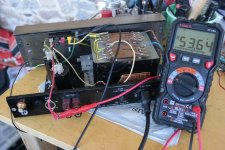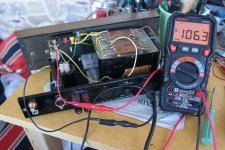I was measuring 69v dc at the boardsStill not clear what made him investigate, meaning what was the problem.
maybe changing the wire colour has worked some magic ;-)Not so fast.
FIRST answer:
To which I would add out of abundance of precaution (and because that is the capacitor blowing voltage):
measure across each capacitor legs (or those nifty screw terminal blocks clamped to each one) and post results.
Special negative points for having use RED as "ground".
Feel free to use any colour for ground except Red or Black which have very specific meanings.
Attachments
We are still missing one measurement 🙂
I asked you to measure straight across each capacitor legs, that´s two, and you added as a bonus voltage across the full string, not bad but again, not what I asked.
Hint: voltage across one capacitor legs is what blows it.
PS: if at all possible, place both test probes straight across each capacitor terminal strips, very easy to do and reassuring.
Clamping to wires who twist all over the place and at moments disappear behind others is not reassuring, specially considering past accidents.
I asked you to measure straight across each capacitor legs, that´s two, and you added as a bonus voltage across the full string, not bad but again, not what I asked.
Hint: voltage across one capacitor legs is what blows it.
PS: if at all possible, place both test probes straight across each capacitor terminal strips, very easy to do and reassuring.
Clamping to wires who twist all over the place and at moments disappear behind others is not reassuring, specially considering past accidents.
53.35V On one 53.38 the otherWe are still missing one measurement 🙂
I asked you to measure straight across each capacitor legs, that´s two, and you added as a bonus voltage across the full string, not bad but again, not what I asked.
Hint: voltage across one capacitor legs is what blows it.
PS: if at all possible, place both test probes straight across each capacitor terminal strips, very easy to do and reassuring.
Clamping to wires who twist all over the place and at moments disappear behind others is not reassuring, specially considering past accidents.
Thanks and many thanks to everyone else who contributed, however I still do not understand where I got the original measurement from!NOW I know they will work fine 🙂
I suggest you measured 69VC across the transformer secondary, just as the moderator guessed when the thread was split.
It would have helped if you hadn't taken a week to measure across the capacitors, which you were asked to do in #18, #27, and #43.
It would have helped if you hadn't taken a week to measure across the capacitors, which you were asked to do in #18, #27, and #43.
Do forgive me for having a lifeI suggest you measured 69VC across the transformer secondary, just as the moderator guessed when the thread was split.
It would have helped if you hadn't taken a week to measure across the capacitors, which you were asked to do in #18, #27, and #43.
'Having a life' didn't stop you trying all sorts of other things, including blowing up a $50 capacitor. All of this could have been avoided.
It really baffles me why people post questions on the Internet when they're not interested in the answers.
It really baffles me why people post questions on the Internet when they're not interested in the answers.
Do forgive me for having a life
We too, and yet here we are waiting for your measurements 😉
- Home
- Amplifiers
- Solid State
- Incorrect secondary voltages on QUAD 405 transformer

